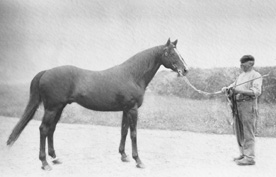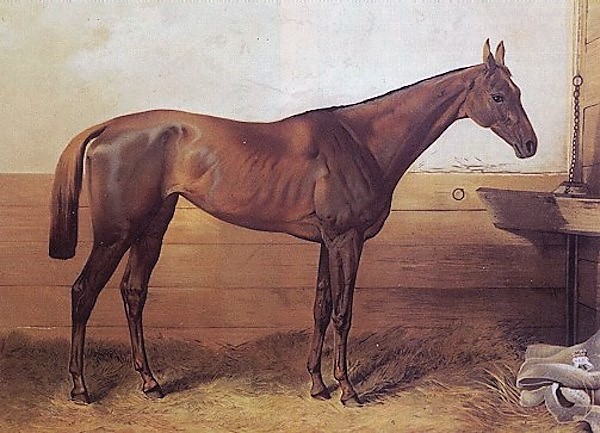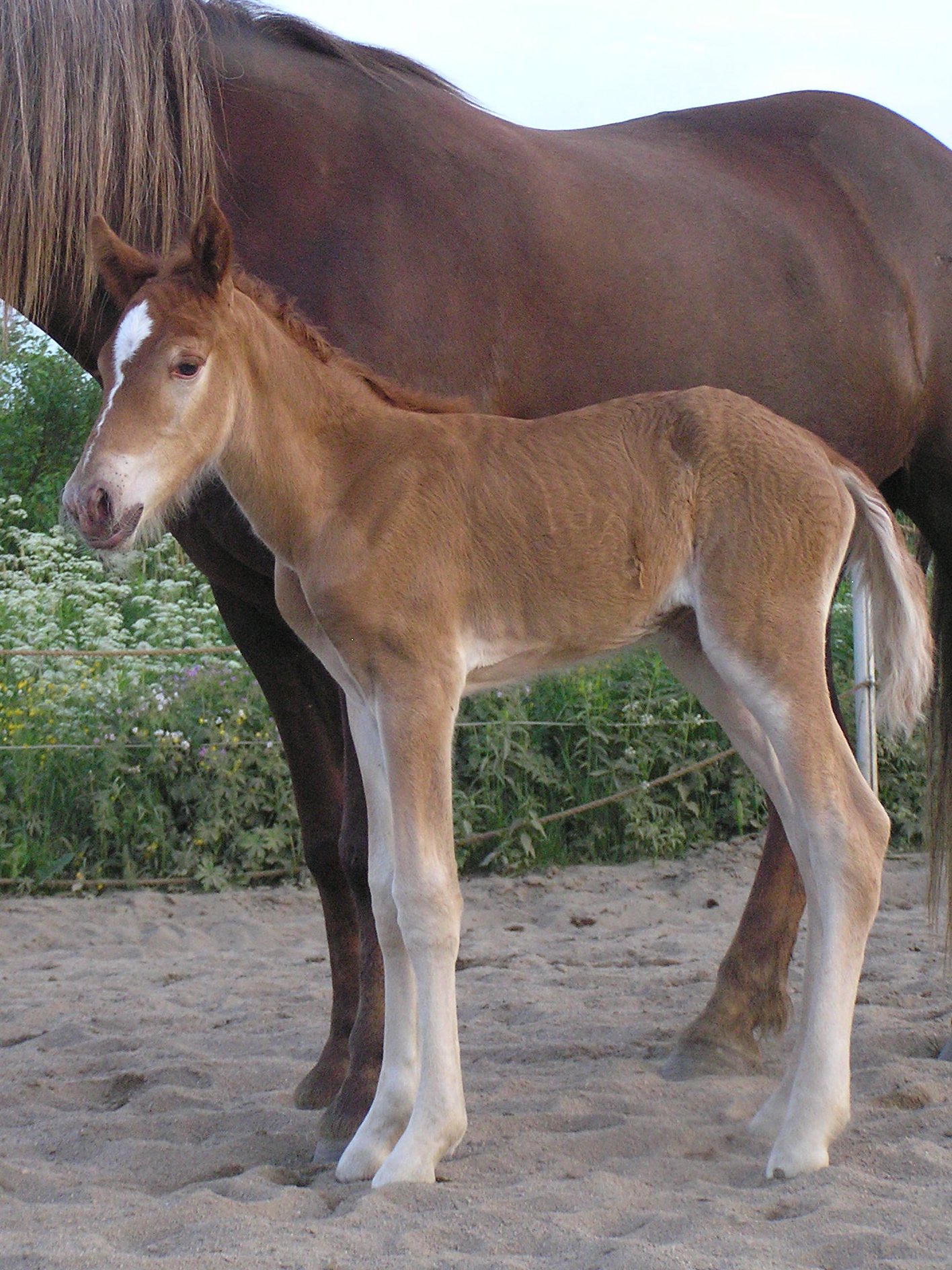|
Ajax (horse)
Ajax (1901 – 15 February 1915) was an undefeated French Thoroughbred racehorse who won the 1904 Prix du Jockey Club and Grand Prix de Paris and was an influential sire. Breeding Bred and raced by Edmond Blanc, he was by Flying Fox and out of Amie, whose sire Clamart also won the Grand Prix de Paris. Ajax is a brother to Adam, a sire who was exported to the United States in 1906 and then in 1908 to Austria.Pryor, Peter, ''The Classic Connection'', Cortney Publications, Luton, 1979 Racing record Ajax was trained by Robert Denman and ridden by jockey, George Stern. In 1904 the three-year-old colt won the two most prestigious races in France, the Prix du Jockey Club and the Grand Prix de Paris before retiring undefeated after five starts. At stud, Ajax was an influential stallion who sired Union (his first classic winner and the 3rd dam of Le Pacha) and Teddy. His daughters produced the undefeated Havresac II, Invershin, Massine and Le Correge. Ajax died on 15 February ... [...More Info...] [...Related Items...] OR: [Wikipedia] [Google] [Baidu] |
Flying Fox (horse)
Flying Fox (1896–1911) was a champion British Thoroughbred racehorse who won the 1899 English Triple Crown and was the leading sire in France three times. Background He was sired by Orme who in turn was sired by Ormonde, the 1886 Triple Crown winner. Their victories made owner Hugh Grosvenor, 1st Duke of Westminster, the only person to own two English Triple Crown winners. His dam was the high-strung mare, somewhat aptly named Vampire, by Galopin. Vampire also produced these horses from six matings with Orme: Flying Lemur (£1,325, a stud failure); Vamose (£5,604 and at stud in France with limited success) and Pipistrello (a non-winner and useless as a stallion), Wetaria, and Vane (produced the Royal Hunt Cup and Ebor Handicap winner, Weathervane). Flying Fox was intensely inbred (3m x 2f) to Galopin.Morris, Simon; ''Tesio Power 2000 - Stallions of the World'', Syntax Software Racing career Flying Fox was a very difficult colt to handle and only raced for two years. Howev ... [...More Info...] [...Related Items...] OR: [Wikipedia] [Google] [Baidu] |
George Stern
Georges Stern (1882 – October 28, 1928), nicknamed "The King of the Derbies"and "King of the Jockeys", was a French jockey. He rode in both England and France. Stern, who was Jewish, was born in France to British parents, who were naturalized in France. In 1904, he won the Grand Prix, the French Derby (riding Ajax), the French Oaks (Profane), the Austrian Derby (Con Amore), the German Derby (Con Amore), and the Baden Baden Prix (Caius). In 1908 he won the French Derby, the Austrian Derby, and the German Derby, and finished second in the Belgian Derby. In 1898, at 17 years of age, in Colombes Stern won his first race riding Finlas, a horse owned and trained by his father. In 1900, he won the debut Grand Prix de Deauville, riding Amedee. That year, with 91 wins he ranked as the best jockey in the world. He won the Deauville again in 1901 (riding Jacobite), 1902 (Maximum), and 1909 ( Biniou). He won the 1911 Epsom Derby (riding Sunstar). He was a six-time winner of the Prix ... [...More Info...] [...Related Items...] OR: [Wikipedia] [Google] [Baidu] |
List Of Leading Thoroughbred Racehorses
The list of leading Thoroughbred racehorses contains the names of undefeated racehorses and other horses that had an outstanding race record in specific categories. Note though that many champions do not appear on the list as an unexpected defeat may be caused by many factors such as injury, illness, going, racing tactics and differences in weight carried, the latter being particularly significant in North America and Australia where handicaps are common even at the highest level of racing. It is common to compare racehorses on multiple factors such as their overall race record, the quality of the horses they beat and the brilliance of their wins. Comparison of raw times is generally unreliable between horses of different eras or even over different racecourses due to a variety of factors such as the racing surface and the pace at which the race is run. Timeform ratings, introduced in 1948, and Beyer Speed Figures, introduced in the United States in 1992, are relatively recent ... [...More Info...] [...Related Items...] OR: [Wikipedia] [Google] [Baidu] |
Inbreeding
Inbreeding is the production of offspring from the mating or breeding of individuals or organisms that are closely related genetically. By analogy, the term is used in human reproduction, but more commonly refers to the genetic disorders and other consequences that may arise from expression of deleterious or recessive traits resulting from incestuous sexual relationships and consanguinity. Animals avoid incest only rarely. Inbreeding results in homozygosity, which can increase the chances of offspring being affected by recessive traits. In extreme cases, this usually leads to at least temporarily decreased biological fitness of a population (called inbreeding depression), which is its ability to survive and reproduce. An individual who inherits such deleterious traits is colloquially referred to as ''inbred''. The avoidance of expression of such deleterious recessive alleles caused by inbreeding, via inbreeding avoidance mechanisms, is the main selective reason for outcrossin ... [...More Info...] [...Related Items...] OR: [Wikipedia] [Google] [Baidu] |
Chestnut (coat)
Chestnut is a hair coat color of horses consisting of a reddish-to-brown coat with a mane and tail the same or lighter in color than the coat. Chestnut is characterized by the absolute absence of true black hairs. It is one of the most common horse coat colors, seen in almost every breed of horse. Chestnut is a very common coat color but the wide range of shades can cause confusion. The lightest chestnuts may be mistaken for palominos, while the darkest shades can be so dark they appear black. Chestnuts have dark brown eyes and black skin, and typically are some shade of red or reddish brown. The mane, tail, and legs may be lighter or darker than the body coat, but unlike the bay they are never truly black. Like any other color of horse, chestnuts may have pink skin with white hair where there are white markings, and if such white markings include one or both eyes, the eyes may be blue. Chestnut foals may be born with pinkish skin, which darkens shortly afterwards. Chestnu ... [...More Info...] [...Related Items...] OR: [Wikipedia] [Google] [Baidu] |
Equine Coat Color
Horses exhibit a diverse array of coat colors and distinctive markings. A specialized vocabulary has evolved to describe them. While most horses remain the same color throughout life, a few, over the course of several years, will develop a different coat color from that with which they were born. Most white markings are present at birth, and the underlying skin color of a healthy horse does not change. Some Equine coat colors are also related to the breed of horse, like the Friesian breed for instance. The basic outline of equine coat color genetics has largely been resolved, and DNA tests to determine the likelihood that a horse will have offspring of a given color have been developed for some colors. Discussion, research, and even controversy continues about some of the details, particularly those surrounding spotting patterns, color sub-shades such as "sooty" or " flaxen", and markings. Basic coat colors The two basic pigment colors of horse hairs are pheomelanin ("red") ... [...More Info...] [...Related Items...] OR: [Wikipedia] [Google] [Baidu] |
Dollar (horse)
Dollar is the name of more than 20 currencies. They include the Australian dollar, Brunei dollar, Canadian dollar, Hong Kong dollar, Jamaican dollar, Liberian dollar, Namibian dollar, New Taiwan dollar, New Zealand dollar, Singapore dollar, United States dollar, Trinidad and Tobago Dollar and several others. The symbol for most of those currencies is the dollar sign $ in the same way as many countries using peso currencies. Economies that use a "dollar" Other territories that use a "dollar" * : Eastern Caribbean dollar * (Netherlands): US dollar * : US dollar (alongside the pound sterling) * : US dollar * : Eastern Caribbean dollar * (Netherlands): US dollar * (France): Canadian dollar (alongside the euro) * (Netherlands): US dollar * : US dollar Countries unofficially accepting "dollars" * Afghanistan: US dollar * Argentina: US dollar * Bolivia: US dollar * Cambodia: US dollar * Cuba: US dollar * Guatemala: US dollar * Lebanon: US dollar * Macau: Hong Ko ... [...More Info...] [...Related Items...] OR: [Wikipedia] [Google] [Baidu] |
Vedette (horse)
Vedette (1854–1881) was a British Thoroughbred racehorse who won the 2000 Guineas Stakes and two Doncaster Cups. He also sired Epsom Derby winner and Champion sire, Galopin. He was owned by Thomas Dundas, 2nd Earl of Zetland and trained by George Abdale. Background Vedette was bred by Mr. Chilton and Anthony Harrison and was a brown (almost black) colt foaled in 1854. He was sired by Epsom Derby and St. Leger Stakes winner Voltigeur. His dam was Mrs. Ridgway, a daughter of Birdcatcher. Racing career 1856: two-year-old season In August 1856 he finished third in the Eglington Stakes over one mile at York. The race was won by the favourite Augury. In October he won the Bedford Stakes at by two lengths from The Western Power, after starting as the 4/6 favourite. At the end of the year he was priced around 7/1 for the 1857 2000 Guineas Stakes. 1857: three-year-old season Vedette returned to the racecourse as a three-year-old in the 2000 Guineas Stakes at Newmarket. He start ... [...More Info...] [...Related Items...] OR: [Wikipedia] [Google] [Baidu] |
Lily Agnes
Lily Agnes (1871–1899) is an English Thoroughbred racehorse. On the track she won 21 races including the Northumberland Plate, Doncaster Cup and Ebor Handicap. She is best known for being the dam of unbeaten Triple Crown winner Ormonde, but she also produced a number of other top foals. When she was in training she was described as "a light-fleshed, ragged hipped, lop-eared filly". Race career Lily Agnes was the daughter of 2000 Guineas and Epsom Derby winner Macaroni, out of Polly Agnes who had been given to James Snarry by Sir Tatton Sykes. As a two-year-old Lily Agnes won all of her six starts. As a three-year-old she won seven of her ten starts, her victories included the Northumberland Plate and Doncaster Cup. She won a further eight races, including the Ebor Handicap at York. Stud career Her owner James Snarry died in 1877. Lily Agnes went on to become one of the top broodmares producing a number of good racehorses and broodmares. After Lily Agnes visited Doncaster ... [...More Info...] [...Related Items...] OR: [Wikipedia] [Google] [Baidu] |
Bend Or
Bend Or (1877–1903) was a British Thoroughbred racehorse who won the 1880 Epsom Derby. His regular jockey Fred Archer, winner of thirteen consecutive British jockey titles, said Bend Or was probably the greatest horse he had ever ridden. Nomenclature His name is the heraldic term for "a bend (i.e. diagonal stripe) that is golden or yellow in color ( or)", and is a reference to the ancient former arms of the Grosvenor family which were adjudged against them in 1389 to the Scrope family in the most famous case ever heard before the Court of Chivalry, known as ''Scrope v Grosvenor''. The Duke also awarded it as a lifelong family nickname to his grandson Hugh Grosvenor, 2nd Duke of Westminster (1879–1953), born in the year before the Derby win. Bendor Range is named after the horse. Breeding Bred and foaled at the 1st Duke of Westminster's Eaton Stud, Bend Or grew to be a large stallion but was noted for his unusual docility. He was a chestnut colt who stood and had a white ... [...More Info...] [...Related Items...] OR: [Wikipedia] [Google] [Baidu] |
Galopin
Galopin (1872–1899) was a Great Britain, British Thoroughbred horse racing, racehorse and Horse breeding#Terminology, sire. In a racing career which lasted from June 1874 until October 1875 he ran nine times and won eight races. He was one of the best British two-year-olds of 1874, winning his first three races before sustaining the only defeat of his career in the Middle Park Plate. In 1875, he won all five of his races including the Epsom Derby, Derby. At the end of the season he was retired to stud where he became an extremely successful and influential breeding stallion. Background Galopin was a bay stallion standing 15.3 Hand (unit), hands high, bred in Lincolnshire by William Taylor Sharpe. His reported sire, Vedette (horse), Vedette, was a successful racehorse, winning the Great Yorkshire Stakes, the Doncaster Cup (twice), and the 1857 2,000 Guineas Stakes. Vedette's value as a stallion had declined to such an extent that he was sold at auction for 42 Guinea (British coi ... [...More Info...] [...Related Items...] OR: [Wikipedia] [Google] [Baidu] |
Ormonde (horse)
Ormonde (1883–1904) was an undefeated English Thoroughbred racehorse who won the 1886 Triple Crown of Thoroughbred Racing, English Triple Crown and was labelled the 'horse of the century' at the time. He also won the St. James's Palace Stakes, Champion Stakes and the Hardwicke Stakes twice. Ormonde was trained at Kingsclere by John Porter (horseman), John Porter for the Hugh Grosvenor, 1st Duke of Westminster, 1st Duke of Westminster. His regular jockeys were Fred Archer (jockey), Fred Archer and Tom Cannon, Sr., Tom Cannon. After retiring from racing he suffered fertility problems, but still sired Orme (horse), Orme, who won the Eclipse Stakes twice. Background Ormonde was a bay colt (horse), colt, bred by Hugh Grosvenor, 1st Duke of Westminster and foaled in 1883 at Eaton Stud in Cheshire. Ormonde's sire was Epsom Derby, The Derby and Champion Stakes winner Bend Or, also bred by the Duke. Bend Or was a successful stallion, his progeny included Kendal (horse), Kendal, Ossory ( ... [...More Info...] [...Related Items...] OR: [Wikipedia] [Google] [Baidu] |




